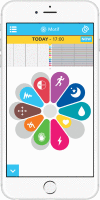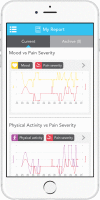Using a smartphone-based self-management platform to support medication adherence and clinical consultation in Parkinson's disease
- PMID: 28649602
- PMCID: PMC5460235
- DOI: 10.1038/s41531-016-0003-z
Using a smartphone-based self-management platform to support medication adherence and clinical consultation in Parkinson's disease
Erratum in
-
Erratum: Author Correction: Using a smartphone-based self-management platform to support medication adherence and clinical consultation in Parkinson's disease.NPJ Parkinsons Dis. 2017 Nov 13;3:32. doi: 10.1038/s41531-017-0034-0. eCollection 2017. NPJ Parkinsons Dis. 2017. PMID: 29152558 Free PMC article.
Abstract
The progressive nature of Parkinson's disease, its complex treatment regimens and the high rates of comorbid conditions make self-management and treatment adherence a challenge. Clinicians have limited face-to-face consultation time with Parkinson's disease patients, making it difficult to comprehensively address non-adherence. Here we share the results from a multi-centre (seven centres) randomised controlled trial conducted in England and Scotland to assess the impact of using a smartphone-based Parkinson's tracker app to promote patient self-management, enhance treatment adherence and quality of clinical consultation. Eligible Parkinson's disease patients were randomised using a 1:1 ratio according to a computer-generated random sequence, stratified by centre and using blocks of variable size, to intervention Parkinson's Tracker App or control (Treatment as Usual). Primary outcome was the self-reported score of adherence to treatment (Morisky medication adherence scale -8) at 16 weeks. Secondary outcomes were Quality of Life (Parkinson's disease questionnaire -39), quality of consultation for Parkinson's disease patients (Patient-centred questionnaire for Parkinson's disease), impact on non-motor symptoms (Non-motor symptoms questionnaire), depression and anxiety (Hospital anxiety and depression scale) and beliefs about medication (Beliefs about Medication Questionnaire) at 16 weeks. Primary and secondary endpoints were analysed using a generalised linear model with treatment as the fixed effect and baseline measurement as the covariate. 158 patients completed the study (Parkinson's tracker app = 68 and TAU = 90). At 16 weeks Parkinson's tracker app significantly improved adherence, compared to treatment as usual (mean difference: 0.39, 95%CI 0.04-0.74; p = 0.0304) with no confounding effects of gender, number of comorbidities and age. Among secondary outcomes, Parkinson's tracker app significantly improved patients' perception of quality of consultation (0.15, 95% CI 0.03 to 0.27; p = 0.0110). The change in non-motor symptoms was -0.82 (95% CI -1.75 to 0.10; p = 0.0822). 72% of participants in the Parkinson's tracker app group continued to use and engage with the application throughout the 16-week trial period. The Parkinson's tracker app can be an effective and novel way of enhancing self-reported medication adherence and quality of clinical consultation by supporting self-management in Parkinson's disease in patients owning smartphones. Further work is recommended to determine whether the benefits of the intervention are maintained beyond the 16 week study period.
Figures
References
-
- European Parkinson’s Disease Association (EPDA) What is Parkinson’s?http://www.epda.eu.com/en/pd-info/about-parkinsons/
LinkOut - more resources
Full Text Sources
Other Literature Sources







